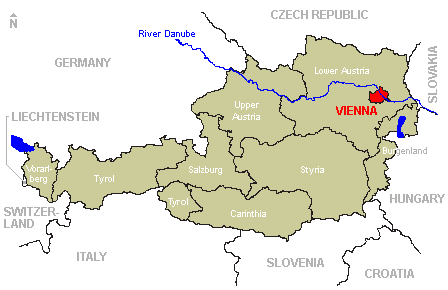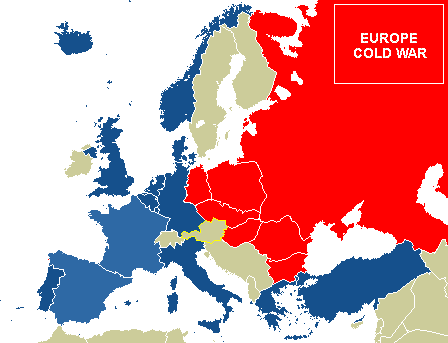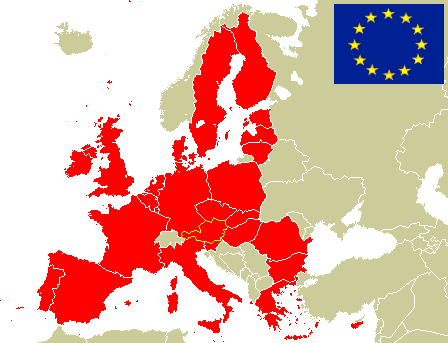|
||
 |
| © Tirolwerbung |
| General information Austria is located in the south-east of Central Europe. The Alps account for almost two thirds of the country, with the Mount Grossglockner (3.798m) as its highest point. The countryside of eastern Austria is flat and hilly. 47% of Austria is covered with forest. Austria is a federal parliamentary democracy divided into nine provinces, namely Burgenland, Carinthia, Lower Austria, Upper Austria, Salzburg, Styria, Tirol, Vorarlberg and the capital Vienna. |
 01. Austria and its neighbours |
 State Flag  Coat of Arms |
Geographic coordinates: 47 20 N, 13 20 E Total area: 83.858 square kilometers Population: 8,3 million (2005) - 99 per square kilometer Capital: Vienna (1,66 million population in 2005) Official Languages: German (regionally also Slovenian, Croatian, Hungarian) Religions: Roman Catholic, Protestant Government Type: Federal republic with parliamentary democracy GDP: EUR 245,1 billion (2005), per capita EUR 29.800 Currency: 1 Euro (€) = 100 Cents Export-partners: Germany 31.9%, Italy 9.6%, Switzerland 5.2%, US 4.9%, France 4.8%, UK 4.7% (2003) Import-partners: Germany 43.2%, Italy 6.7%, Hungary 5.4%, Switzerland 5%, Netherlands 4.2% (2003) |
| Memberships: - European Union (1995) - United Nations (1955) - the headquarters of the International Atomic Energy Organization IAEO and the United Nations Industrial Development Organization UNIDO are located in Vienna - OSCE - Organization for Security and Co-Operation in Europe (1973), - observer to WEU - Western European Union (1992) - PfP - Partnership for Peace (1995) - CENCOOP (1998) - Central European Nations Cooperation in Peace Support - by constitution, Austria is not allowed to become a member of a military organization like the NATO or the WEU. |
| Austria
in the 20th and 21st century Once the center of power for the large Austro-Hungarian Empire, Austria was reduced to a small republic after World War I. The Republic of Austria was established on November 12, 1918. Following annexation by Germany in 1938 and the occupation by the allied troops in 1945, Austria's status remained unclear for a decade. State Treaty signed on October 26, 1955 ended the occupation, recognized Austria's independence. This date became the national holyday. As a condition for Soviet military withdrawal, an additional constitutional law declared the country's "perpetual neutrality". |
 02. Austria durning Cold War (before 1991) |
| Jammed between NATO and the Warsaw Pact, Austria began working its way up into the worlds ten richest countries. After the collapse of the Soviet Union's in 1991, Austria joined the European Union in 1995. Due to the EU and NATO enlargement in 2004, Austria seized being an "eternal border country" and is now located in the middle of the European Union. |
 03. Austria and the European Union (2009) |
 04. Austria and the NATO (2009) |
|
|||